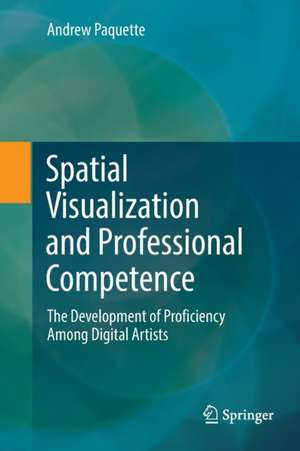Spatial Visualization and Professional Competence: The Development of Proficiency Among Digital Artists
Autor Andrew Paquetteen Limba Engleză Paperback – 8 feb 2019
This book follows a narrow focus, as students develop proficiency in a cognitively challenging task known as ‘NURBS modelling’. This task was chosen due to an observed relationship between students who succeeded in the task, and students who successfully obtained employment after graduation. In the study this is based on, readers will be shown that knowledge-based explanations for the development of proficiency do not adequately account for proficiency or expertise in this field, where visualisation has been observed to develop suddenly rather than over an extended period of time. This is an unusual but not unique observation. Other studies have shown rapid development of proficiency and expertise in certain professions, such as among telegraph operators, composers and chess players. Based on these observations, the book argues that threshold concepts play a key role in the development of expertise among CG artists.
| Toate formatele și edițiile | Preț | Express |
|---|---|---|
| Paperback (1) | 329.44 lei 6-8 săpt. | |
| Springer International Publishing – 8 feb 2019 | 329.44 lei 6-8 săpt. | |
| Hardback (1) | 335.69 lei 6-8 săpt. | |
| Springer International Publishing – 11 sep 2018 | 335.69 lei 6-8 săpt. |
Preț: 329.44 lei
Preț vechi: 411.80 lei
-20% Nou
Puncte Express: 494
Preț estimativ în valută:
63.05€ • 65.58$ • 52.05£
63.05€ • 65.58$ • 52.05£
Carte tipărită la comandă
Livrare economică 14-28 aprilie
Preluare comenzi: 021 569.72.76
Specificații
ISBN-13: 9783030082130
ISBN-10: 303008213X
Pagini: 217
Ilustrații: XVIII, 217 p. 58 illus., 3 illus. in color.
Dimensiuni: 155 x 235 mm
Greutate: 0.34 kg
Ediția:Softcover reprint of the original 1st ed. 2018
Editura: Springer International Publishing
Colecția Springer
Locul publicării:Cham, Switzerland
ISBN-10: 303008213X
Pagini: 217
Ilustrații: XVIII, 217 p. 58 illus., 3 illus. in color.
Dimensiuni: 155 x 235 mm
Greutate: 0.34 kg
Ediția:Softcover reprint of the original 1st ed. 2018
Editura: Springer International Publishing
Colecția Springer
Locul publicării:Cham, Switzerland
Cuprins
Introduction.- Literature Review.- Methodology.- Quantitative Findings.- Qualitative Findings.- Discussion.- Conclusion.
Notă biografică
Andrew Paquette began his career as a visual artist in 1986. He worked in a number of roles, including editorial illustrator, comic book artist, 3D modeler, character designer, texture artist, animator, storyboard artist, concept artist, and art director in video games and motion pictures. He left industry to become an educator in 2006, when he became one of the founders of the visual arts programme at the Breda University of Applied Sciences (formerly NHTV). Since then, he has written several textbooks on computer graphics, and completed his PhD at King's College, London. His research centres on the intersection of educational methods, student needs, and industry standards for employment.
Textul de pe ultima copertă
The computer graphics (CG) industry is an attractive field for undergraduate students, but employers often find that graduates of CG art programmes are not proficient. The result is that many positions are left vacant, despite large numbers of job applicants. This book investigates how student CG artists develop proficiency. The subject is important to the rapidly growing number of educators in this sector, employers of graduates, and students who intend to develop proficiency for the purpose of obtaining employment. Educators will see why teaching software-oriented knowledge to students does not lead to proficiency, but that the development of problem-solving and visualisation skills do.
This book follows a narrow focus, as students develop proficiency in a cognitively challenging task known as ‘NURBS modelling’. This task was chosen due to an observed relationship between students who succeeded in the task, and students who successfully obtained employment after graduation. In the study this is based on, readers will be shown that knowledge-based explanations for the development of proficiency do not adequately account for proficiency or expertise in this field, where visualisation has been observed to develop suddenly rather than over an extended period of time. This is an unusual but not unique observation. Other studies have shown rapid development of proficiency and expertise in certain professions, such as among telegraph operators, composers and chess players. Based on these observations, the book argues that threshold concepts play a key role in the development of expertise among CG artists.
This book follows a narrow focus, as students develop proficiency in a cognitively challenging task known as ‘NURBS modelling’. This task was chosen due to an observed relationship between students who succeeded in the task, and students who successfully obtained employment after graduation. In the study this is based on, readers will be shown that knowledge-based explanations for the development of proficiency do not adequately account for proficiency or expertise in this field, where visualisation has been observed to develop suddenly rather than over an extended period of time. This is an unusual but not unique observation. Other studies have shown rapid development of proficiency and expertise in certain professions, such as among telegraph operators, composers and chess players. Based on these observations, the book argues that threshold concepts play a key role in the development of expertise among CG artists.
Caracteristici
Explains why experience or practice isn’t always enough to develop proficiency Demonstrates flaws in current spatial visualisation testing Enriches understanding of domain differences in the development of proficiency and expertise Provides data supportive of cognition enrichment as a teaching method Broadens understanding of the relationship between threshold concepts and expertise
